
Dessert is a course that concludes a meal. The course consists of sweet foods, such as cake, biscuit, ice cream and possibly a beverage such as dessert wine and liqueur. Some cultures sweeten foods that are more commonly savory to create desserts. In some parts of the world there is no tradition of a dessert course to conclude a meal.

Sri Lankan cuisine is known for its particular combinations of herbs, spices, fish, vegetables, rices, and fruits. The cuisine is highly centered around many varieties of rice, as well as coconut which is a ubiquitous plant throughout the country. Seafood also plays a significant role in the cuisine, be it fresh fish or preserved fish. As a country that was a hub in the historic oceanic silk road, contact with foreign traders brought new food items and cultural influences in addition to the local traditions of the country's ethnic groups, all of which have helped shape Sri Lankan cuisine. Influences from Indian, Indonesian and Dutch cuisines are most evident with Sri Lankan cuisine sharing close ties to other neighbouring South and Southeast Asian cuisines.
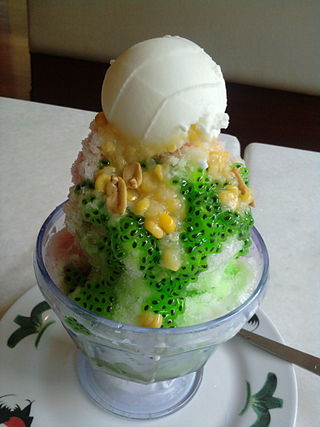
Ais kacang, literally meaning "bean ice", also commonly known as ABC, meaning "mixed ice"), is a Malaysian dessert which is common in Malaysia, Singapore and Brunei.

A falooda is a Mughalai cold dessert made with vermicelli. It has origins in the Persian dish faloodeh, variants of which are found across West, Central, South and Southeast Asia. Traditionally it is made by mixing rose syrup, vermicelli, and sweet basil seeds with milk, often served with ice cream. The vermicelli used for preparing falooda is made from wheat, arrowroot, cornstarch, or sago.
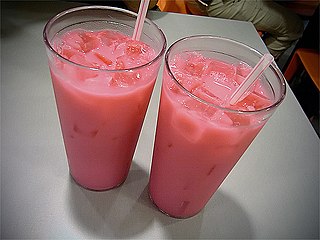
Bandung, sirap bandung, air bandung, iced bandung or rose syrup drink is a drink popular in Maritime Southeast Asia, notably in Brunei, Indonesia, Malaysia and Singapore. It consists of evaporated milk or condensed milk flavoured with rose syrup, giving it a pink colour.

Peranakan cuisine or Nyonya cuisine comes from the Peranakans, descendants of early Chinese migrants who settled in Penang, Malacca, Singapore and Indonesia, inter-marrying with local Malays. In Baba Malay, a female Peranakan is known as a nonya, and a male Peranakan is known as a baba. The cuisine combines Chinese, Malay, Javanese, South Indian, and other influences.
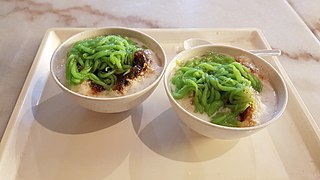
Cendol is an iced sweet dessert that contains droplets of pandan-flavoured green rice flour jelly, coconut milk and palm sugar syrup. It is commonly found in Southeast Asia and is popular in Indonesia, Malaysia, Brunei, Cambodia, East Timor, Laos, Vietnam, Thailand, Singapore, Philippines, and Myanmar. Next to the green jelly, additional toppings might be added, including diced jackfruit, sweetened red azuki beans, or durian.
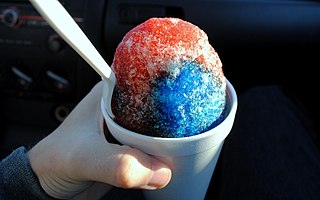
Shaved ice is a large family of ice-based desserts made of fine shavings of ice and sweet condiments or syrups. Usually, the syrup is added after the ice has been frozen and shaved—typically at the point of sale; however, flavoring can also be added before freezing. The dessert is consumed worldwide in various forms and ways. Shaved ice can also be mixed with large quantities of liquid to produce shaved ice drinks.
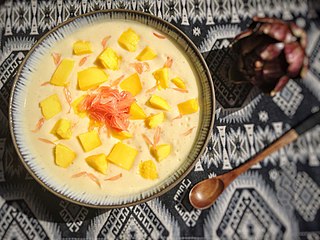
Chè is any traditional Vietnamese sweet beverage, dessert soup or stew, or pudding. Chè includes a wide variety of distinct soups or puddings. Varieties of Chè can be made with mung beans, black-eyed peas, kidney beans, tapioca, jelly, fruit, and coconut cream. Other types are made with ingredients such as salt, aloe vera, seaweed, lotus seed, sesame seed, sugar palm seeds, taro, cassava and pandan leaf extract. Some varieties, such as chè trôi nước, may also include dumplings. Chè are often prepared with one of a number of varieties of beans, tubers, and/or glutinous rice, cooked in water and sweetened with sugar. In southern Vietnam, chè are often garnished with coconut creme.

Frozen dessert is a dessert made by freezing liquids, semi-solids, and sometimes solids. They may be based on flavored water, on fruit purées, on milk and cream, on custard, on mousse (semifreddo), and others. It is sometimes sold as ice-cream in South Asia and other countries.

Platostoma palustre, commonly known as Chinese mesona, is a species of plant belonging to the genus Platostoma of the mint family. The species grows extensively in East Asia such as south east China, Japan and Taiwan preferring ravines, grassy, dry, and sandy areas. The plants are from 15 to 100 cm high with hairy stems and leaves. The leaves are tear-drop shaped and serrated.

The cuisine of Mauritius is greatly influenced by the tropical location of the island as well as the cultural diversity which characterizes the country. Mauritian cuisine is a blend of African, Chinese, European and Indian influences in the history of Mauritius. Most of the dishes and culinary traditions are inspired by French culture, former African slaves, Indian workers and Chinese migrants that arrived in the country during the 19th century. Over the years, communities found in Mauritius have adapted and mixed each other's cuisine to their liking, resulting in the development of Mauritian cuisine. While some popular dishes and desserts are consumed by Mauritians of all ethnic groups or communities, there are also forms of cuisines which remain distinctly ethnic and are unique to a specific ethnic community due to their ancestral cultural and historical connections. Local food which varies depending on ethnic communities therefore reflects the strong traditional, cultural, and historical influences of each community. French cuisine is very popular in Mauritius. Sino-Mauritian cuisine is one of the most prevalent in the restaurants throughout the island.
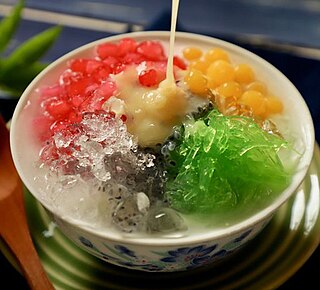
Es campur is an Indonesian cold and sweet dessert concoction of fruit cocktails, coconut, tapioca pearls, grass jellies, etc. served in shaved ice, syrup and condensed milk.

Namkhaeng sai is a Thai version of shaved ice or snow cone. It is also known as wan yen or chamba. Namkhaeng sai is simply shaved ice in a bowl, poured on top with sweet syrup and condensed milk

Platostoma is a genus of flowering plants in the mint family, Lamiaceae, first described as a genus in 1818. It is native to tropical parts of Africa, southern Asia, Papuasia, and Australia. Mesona and Acrocephalus has been known as its synonyms.

Betawi cuisine is rich, diverse and eclectic, in part because the Betawi people that create them were composed from numbers of regional immigrants that came from various places in the Indonesian archipelago, as well as Chinese, Indian, Arab, and European traders, visitors and immigrants that were attracted to the port city of Batavia since centuries ago.

Stephania capitata also known as sumbat kendi or vase plug in Indonesian is a medicinal plant that was commonly used as a substitute of Cyclea barbata to produce green grass jelly.





















